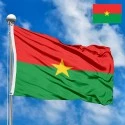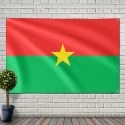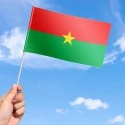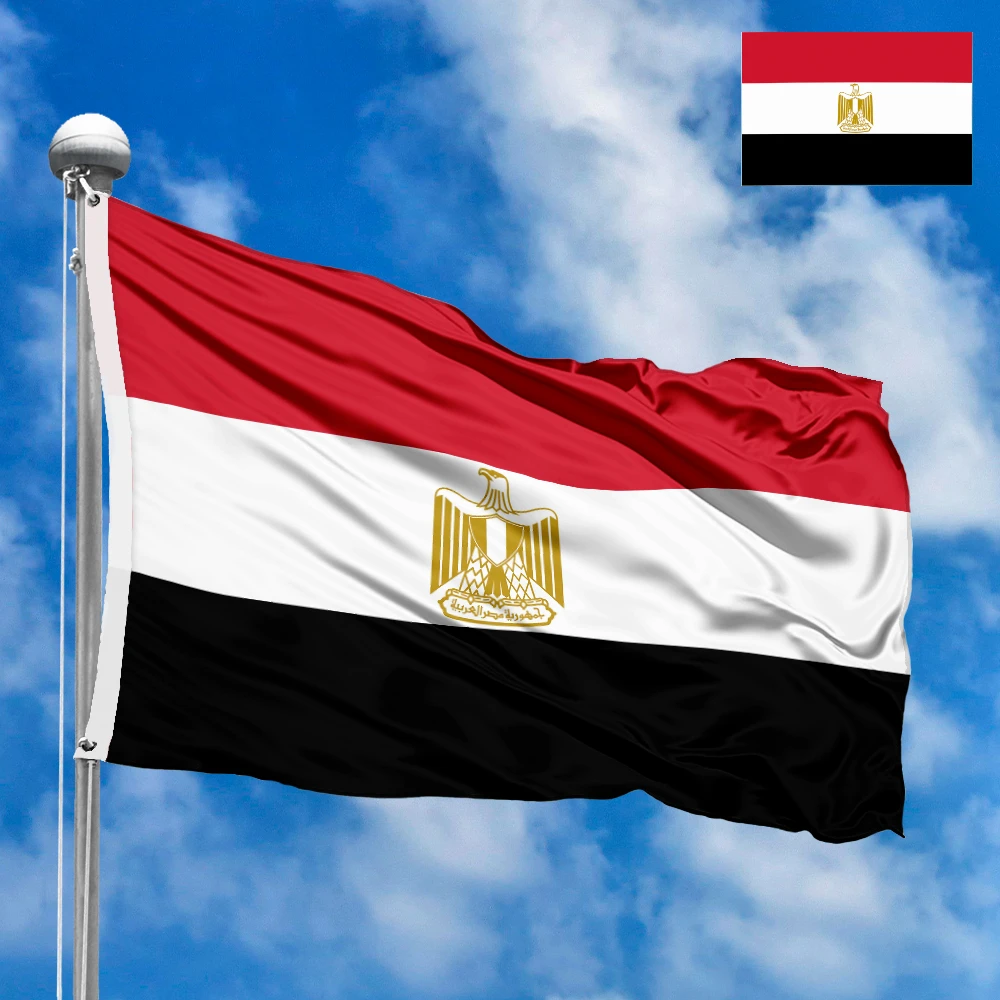Flag of Burkina Faso
- Flag Type: State
- Proportions (official): 2:3
- Official name: Burkina Faso
- Local name: Burkina Faso
- Sovereignty (year): YES (1960)
- Member of Organizations: UN, African Union, Organization of Islamic Cooperation
- Country code, territory: BF, BFA, 854
- Capital: Ouagadougou
- Large cities: Bobo-Dioulasso, Koudougou
- Population: ~24,200,000 (2024, UN)
- Religions: Islam ~60%, Christianity ~23%, Traditional beliefs ~15%
- Area (km²): 274 200
- Highest point: Mount Tenakourou (749 m)
- Lowest point: Volta River (200 m)
- Currency: West African CFA franc (XOF, CFA)
- Languages: French, Moore, Dyula
- Dialing code: +226
- National domain: .bf
Flag Information
General information
Demography and Culture
Economy and communications
- All Flags
- Flags of Countries by Continent
-
Flags of Organizations
- Flags of UN countries
- Flags of the European Union countries
- Flags of NATO countries
- Flags of the countries of the Organization of Islamic Cooperation
- Flags of the countries of the Organization of American States
- Flags of the Arab League countries
- Flags of the African Union countries
- Flags of the countries of the Union of South American Nations
- Flags of the Commonwealth of Nations
- Flags of the countries of the Secretariat of the Pacific Community
- Flags of the Nordic Council countries
- Flags of the Caribbean Community
- Flags of the countries of the Association of Southeast Asian Nations
- Flags of the East African Community
- Flags of the countries of the Organization of Turkic States
- LGBT Community Flags
- Historical Flags
- Ethnic Flags
- Flags of the USA (states)
Description
The national flag of Burkina Faso is a powerful and evocative symbol, deeply intertwined with the country's transformative history and its aspirations for freedom, justice, and development. Adopted on August 4, 1984, a year after the revolution that brought Thomas Sankara to power and renamed the country from Upper Volta to Burkina Faso (meaning "Land of the Upright People" or "Land of Incorruptible People"), the flag embodies the nation's commitment to self-determination, pan-African solidarity, and a socialist-oriented path to progress. It is far more than a mere national emblem; it is a vivid narrative of a nation’s journey towards reclaiming its identity and destiny.
Design and Symbolism: A Revolutionary Canvas of Principles
The flag of Burkina Faso features a distinctive and easily recognizable design: two horizontal stripes of equal width, the upper one red and the lower one green, with a yellow five-pointed star centrally placed on the red stripe. Each element is rich with meaning, reflecting the nation's revolutionary ideals and its vision for the future:
-
The Red Stripe: Revolutionary Struggle and Sacrifices for the Nation. The upper red stripe is a potent symbol of the revolutionary struggle that led to the renaming of the country and its commitment to fundamental social and political transformation. Red, universally associated with courage, passion, and the blood of patriots, signifies the sacrifices made by the Burkinabè people in their fight against oppression, exploitation, and colonialism. It represents the blood shed for freedom and the unwavering determination to defend the nation's sovereignty and dignity. More specifically, in the context of Sankara's revolution, it explicitly denotes the socialist aspirations and the readiness to fight for a more just and equitable society, often interpreted as a commitment to anti-imperialism and self-reliance. It's a tribute to those who laid down their lives for the ideals of national liberation and a progressive future.
-
The Green Stripe: Hope, Abundance, and the Nation's Natural Wealth. The lower green stripe represents the abundant natural wealth of Burkina Faso, particularly its fertile land and agricultural potential. Green, a color of hope, prosperity, and the vibrancy of nature, signifies the nation's agricultural resources, which are crucial for its economic development and the well-being of its people. It embodies the hope for a prosperous future through sustainable development and the harnessing of its natural endowments. Beyond material wealth, green also symbolizes the nation's deep connection to its African roots and its aspirations for environmental stewardship. It implies a commitment to nurturing the land that sustains its people and an optimistic outlook on the nation's ability to achieve self-sufficiency and growth.
-
The Yellow Star: Guiding Light of Revolution, Mineral Wealth, and Pan-Africanism. The prominent yellow five-pointed star, centrally positioned on the red stripe, is the flag's most iconic element and carries multifaceted symbolism:
-
Guiding Light of the Revolution: The star serves as a guiding light of the revolution, illuminating the path towards a new society based on justice, equality, and popular participation. It represents the bright future and the ideals that the nation strives to achieve.
-
Mineral Wealth: Yellow is also the color of gold, symbolizing the nation's mineral wealth, particularly its gold reserves. This acknowledges the economic potential inherent in its natural resources.
-
Pan-Africanism: Perhaps most importantly, the yellow star embodies Pan-Africanism. It signifies solidarity with all peoples of Africa and their struggles for liberation and unity. This links Burkina Faso's revolution to the broader African liberation movements and expresses a commitment to continental cooperation and mutual support. The star, in this context, is a beacon of African unity and collective self-determination.
-
Together, the colors and the star form a cohesive narrative: a nation that has shed blood (red) for a just revolution, aiming for prosperity through its natural resources (green), guided by the principles of justice, wealth, and pan-African solidarity (yellow star). It's a visual pledge to a transformed society and a unified continent.
Dimensions and Proportions: A Balanced Expression of National Pride
The official dimensions and proportions of the Flag of Burkina Faso are meticulously defined to ensure its consistent and recognizable appearance across all forms of display. The flag adheres to a width-to-length ratio of 2:3. This specific ratio is very common among national flags worldwide, providing a balanced and aesthetically pleasing rectangular shape that is easily adaptable for various display purposes, from large ceremonial flags to smaller hand-held versions. The 2:3 ratio is often chosen for its practicality and visual harmony, allowing the design elements to be clearly perceived.
The two horizontal stripes, red and green, are of equal width, signifying the equal importance of the principles they represent – the revolutionary struggle and the nation's natural wealth/hope. This equality in proportion reinforces the balance between the historical sacrifices and the future aspirations of the country.
The central yellow five-pointed star is precisely placed to be the focal point of the flag, centered both horizontally and vertically within the overall design, specifically within the upper (red) stripe. Its size is carefully calculated to ensure visibility and prominence without overwhelming the red stripe or the overall balance of the flag. The five points of the star are distinct and evenly spaced, adding to the flag's visual clarity and symbolic impact. The precise placement of the star within the red stripe is particularly significant, suggesting that the guiding principles of the revolution (represented by the star) are firmly embedded within the revolutionary struggle itself.
This meticulous proportional division ensures that the flag is consistently reproduced correctly, maintaining its intended visual impact and symbolic integrity. Whether displayed at official government buildings, international diplomatic events, sporting competitions, or national celebrations, the 2:3 ratio, the equally sized stripes, and the perfectly centered yellow star ensure that the flag of Burkina Faso always projects a strong, unified, and balanced image. This adherence to precise dimensions is crucial for upholding the flag's dignity and ensuring its accurate representation as a proud national emblem, conveying its message of revolution, hope, and pan-African unity to both its citizens and the world.
History and Evolution: From Colonialism to Revolutionary Identity
The history of the national flag of Burkina Faso is a compelling narrative of a nation's journey from colonial rule to a declared revolutionary identity, marked by a significant name change and a redefinition of its national symbols.
-
Colonial Era (Pre-1960): French Influence. Prior to gaining independence, the territory now known as Burkina Faso was a French colony called Upper Volta (Haute-Volta). During this period, the French Tricolour (blue, white, and red vertical stripes) would have been the official flag. There was no distinct flag representing the indigenous population or the emerging nationalist sentiment during this time.
-
Flag of Upper Volta (1960-1984): The Voltaic Tricolour. On August 5, 1960, Upper Volta gained full independence from France. The flag adopted upon independence was a horizontal tricolour of black, white, and red. These colors were chosen to represent the three main tributaries of the Volta River, which flows through the country: the Black Volta, the White Volta, and the Red Volta. This design was a direct geographical and somewhat understated representation of the nation's namesake. While simple, it symbolized the newly independent state, but it did not carry explicit ideological or pan-African messages.
-
The Revolution and the Birth of Burkina Faso (1983-1984): A Transformative Shift. The pivotal moment in the flag's history, and indeed the nation's, occurred on August 4, 1983, when Captain Thomas Sankara came to power through a military coup. Sankara initiated a radical revolutionary program, seeking to transform Upper Volta into a self-reliant, just, and pan-Africanist society. A year later, on August 4, 1984, to fully reflect this profound ideological shift and break away from colonial legacies, Upper Volta was officially renamed Burkina Faso ("Land of the Upright People" or "Land of Incorruptible People"). Simultaneously, a new national anthem (Dîtanyè) and a new flag were adopted. The current flag, with its red and green stripes and yellow star, was specifically designed to embody the ideals of Sankara's revolution. It deliberately abandoned the "Volta" symbolism, which was seen as a colonial imposition, in favor of colors and symbols with strong political and pan-African connotations.
-
Post-Revolutionary Era (1984-Present): Enduring Symbolism. Despite the assassination of Thomas Sankara in 1987 and subsequent political changes, the flag of Burkina Faso has remained unchanged since its adoption in 1984. This remarkable continuity, despite the shifts in political leadership and ideologies, speaks to the enduring power and broad acceptance of its symbolism among the Burkinabè people. The flag continues to represent the ideals of the 1983 revolution: self-reliance, anti-imperialism, national dignity, and pan-African solidarity. It has transcended specific political regimes to become a deeply ingrained and cherished national symbol that unifies citizens in their aspirations for a better future, reflecting a profound commitment to the principles of a free and upright nation.
In essence, the evolution of Burkina Faso's flag mirrors its journey from a geographical colonial designation to a proud, ideologically driven, and self-defined African nation, with the current flag standing as a powerful testament to its revolutionary spirit and its unwavering commitment to its core values.
Regional Context and West African Identity: A Pan-African Beacon
The flag of Burkina Faso holds a prominent and distinct position within the vexillological landscape of West Africa, largely due to its strong embrace of Pan-African colors and its explicit connection to revolutionary and anti-imperialist ideals. While many West African nations incorporate Pan-African colors (red, yellow/gold, green) into their flags, Burkina Faso's flag design and its historical context give it a unique significance.
-
Strong Pan-African Identity: The Burkinabè flag is a quintessential example of a national flag prominently featuring the Pan-African colors: red, green, and yellow. These colors are derived from the flag of Ethiopia, the only African nation to largely avoid colonial subjugation, and were adopted by Ghana's first president, Kwame Nkrumah, to symbolize African unity and independence. Burkina Faso's use of these colors is not merely decorative; it's a direct declaration of solidarity with other African nations and a commitment to the continent's collective liberation and development. This aligns it closely with nations like Ghana, Senegal, Mali, and Guinea, which also use these colors, but Burkina Faso's context imbues them with a distinct revolutionary fervor.
-
Revolutionary Symbolism in a Post-Colonial Era: Unlike some flags that primarily reflect geographical features or pre-colonial kingdoms, the flag of Burkina Faso is explicitly a product of a revolutionary movement that sought to redefine the nation's identity. The emphasis on the "revolutionary struggle" (red) and the "guiding light of the revolution" (yellow star) sets it apart. This ideological depth distinguishes it from flags that might simply represent independence without such an overt political statement. It positions Burkina Faso as a beacon of radical change and self-determination within the region.
-
Contrast with Former Colonial Master's Influence: While many former French colonies in West Africa retained some elements or influences from French vexillology (e.g., vertical stripes), Burkina Faso's flag represents a clean break from such influences. It rejected the previous flag of Upper Volta, which was based on the Volta River system, in favor of a design that was purely indigenous in its symbolism and aligned with a broader Pan-African, anti-colonial narrative. This deliberate rejection underscored its commitment to a truly independent and self-defined national identity.
-
The "Land of Upright People": The very name "Burkina Faso" and its flag are a testament to the nation's profound commitment to integrity, self-reliance, and dignity. This moral and ethical dimension, clearly articulated through the name change and the flag's symbolism, might not be as explicitly present in the flags of all its neighbors, though common aspirations for progress and peace certainly exist.
-
Regional Cooperation and Solidarity: The Pan-African symbolism of the flag signifies Burkina Faso's desire for strong ties and cooperation within West Africa and the wider African continent. It is a visual pledge to collective action and mutual support in addressing regional challenges, from economic development to security.
In essence, the flag of Burkina Faso is not just a national emblem; it is a revolutionary banner that resonates across West Africa. Its colors and star communicate a clear message of pan-African solidarity, a commitment to justice, and an unwavering belief in the power of its people to shape their own destiny. It stands as a powerful symbol of a nation that explicitly chose its path and identity, becoming an inspiration for similar movements and a proud representative of a distinct ideological stance within the diverse tapestry of African nations.
Interesting Facts About The Flag of Burkina Faso:
-
Born from a Revolution: The current flag was adopted on August 4, 1984, exactly one year after the revolution led by Captain Thomas Sankara, and on the same day the country officially changed its name from Upper Volta to Burkina Faso.
-
Meaning of "Burkina Faso": The country's new name, "Burkina Faso," means "Land of the Upright People" or "Land of the Incorruptible People," reflecting the ideals of integrity and self-reliance that the flag also embodies.
-
Pan-African Colors: The flag uses the Pan-African colors of red, green, and yellow, symbolizing solidarity with other African nations and their struggles for liberation and unity. These colors were popularized by the Ethiopian flag, which represents the only African nation that largely avoided colonial rule.
-
Symbolism of the Star: The yellow five-pointed star is highly significant. It represents the guiding light of the revolution, the mineral wealth of the country (especially gold), and the principle of Pan-Africanism.
-
Replaced a Tricolour: It replaced the flag of Upper Volta, which was a horizontal tricolour of black, white, and red, representing the three main tributaries of the Volta River (Black Volta, White Volta, Red Volta). The new flag deliberately abandoned this geographical symbolism for ideological reasons.
-
Sankara's Vision: The flag is a direct reflection of Thomas Sankara's revolutionary ideology, emphasizing anti-imperialism, self-reliance, and a commitment to justice for the Burkinabè people.
-
Unchanged Since 1984: Despite political changes and the assassination of Sankara in 1987, the flag's design has remained unchanged. This continuity highlights its enduring acceptance as a national symbol.
-
Simple Yet Powerful Design: Its simple two-stripe design with a single central star makes it easily recognizable and visually striking, conveying a clear and strong message.
-
Official Motto Reflection: The flag's colors and the star directly tie into the country's ideals and the spirit of its revolutionary past, rather than a specific national motto.
-
Emphasis on Self-Reliance: The overall symbolism of the flag, combined with the country's name, strongly emphasizes self-reliance and national dignity, which were core tenets of Sankara's policies.
-
Used in Many Contexts: The flag is prominently displayed during national celebrations, public events, and in schools, reinforcing its significance as a symbol of unity and national pride for the Burkinabè people.
Significance for the Inhabitants: A Banner of Revolution, Dignity, and Shared Future
For the people of Burkina Faso, their national flag is far more than a mere emblem; it is a profound and deeply cherished symbol that encapsulates their nation's revolutionary spirit, their collective memory of struggle, and their unwavering aspirations for a dignified and prosperous future. It serves as a constant visual reminder of their hard-won sovereignty and the distinct values that define them as Burkinabè, the "Upright People."
The red stripe at the top of the flag resonates deeply with the Burkinabè people as a tribute to their revolutionary struggle and the sacrifices made for their freedom. After years of colonial rule and subsequent socio-economic challenges, the red color evokes a powerful sense of reverence for those who fought and sacrificed for the nation's liberation and its progressive ideals. It symbolizes the blood shed for justice and self-determination, instilling a profound sense of pride and a collective commitment to upholding the revolutionary principles. For every Burkinabè, it is a reminder of the courage and determination required to build a nation rooted in equity and sovereignty, serving as a powerful call to action to continue the fight for social justice and national dignity.
The green stripe at the bottom embodies the hope for a prosperous future and the deep connection to Burkina Faso's abundant natural wealth. In a nation where agriculture is central to livelihood, the green color is profoundly significant, symbolizing the potential for growth, sustenance, and improved living standards. It represents the fertile lands that can feed the nation and its potential for sustainable development. For the inhabitants, this green is a vivid reminder of their rich natural heritage and the promise it holds for a better quality of life for current and future generations. It fosters a sense of optimism and a belief in the nation's capacity to achieve self-sufficiency and thrive through diligent work and environmental stewardship.
The yellow five-pointed star, centrally positioned on the red stripe, is perhaps the most iconic and evocative element, representing a guiding light for the revolution, the nation's mineral wealth, and most importantly, Pan-Africanism.
-
As a guiding light, it inspires hope and directs the people towards a future built on justice and progress. It symbolizes the bright ideals that illuminate their path.
-
Its yellow color signifies the nation's wealth in gold, reminding citizens of their valuable natural resources and the potential for economic development that these resources offer.
-
Crucially, the star's Pan-African symbolism is a powerful message of solidarity and unity with all African peoples. This resonates deeply, fostering a sense of shared destiny with the broader African continent and underscoring Burkina Faso's commitment to collective liberation and development. For the inhabitants, this star is a constant beacon, uniting them under a common vision of justice, prosperity, and continental solidarity. It is a powerful reminder that their struggle is part of a larger African narrative.
When the flag is proudly displayed—during national celebrations, at schools, on government buildings, during sporting events, or in private homes—it invariably ignites a profound sense of patriotism, unity, and shared identity among the Burkinabè people. It serves as a powerful reminder that despite historical challenges and ongoing struggles, they are united by a common revolutionary heritage, shared aspirations, and a collective commitment to building a dignified, self-reliant, and progressive nation. It is a cherished emblem that evokes deep pride and a collective determination to uphold the values it represents for generations to come, symbolizing the "Land of the Upright People" and their unwavering spirit.
In the demonstration images, full-size flags are shown with proportions of 2:3, and hand-held flags with proportions of 1:2.
Donation
Download
Completely free for commercial and non-commercial use (public domain).
You can freely use them in your news magazines, websites, software, mobile applications.
We appreciate a backlink to https://flagssite.com
Raster files - Flag of Burkina Faso (PNG, JPG)
 Waving flag
Waving flag
- PNG format (transparent background), 72dpi, dimensions in Pixels (px), aspect ratio 3:4.
- 15х20 px
- 30х40 px
- 60х80 px
- 120x160 px
- 240x320 px
 Sizes:
Sizes:
"v15" - image size (by height); if necessary, replace with available: v15, v30, v60, v120, v240.
!!! For resizing, use the Latin (eng) keyboard layout.
<img src="https://flagssite.com/flags/v15/20405.png" alt="Flag of Burkina Faso">
 Round flag
Round flag
- PNG format (transparent background), 72dpi, dimensions in Pixels (px), aspect ratio 1:1.
"d15" - image size (diameter); if necessary, replace with available: d15, d30, d60, d120, d240.
!!! For resizing, use the Latin (eng) keyboard layout.
<img src="https://flagssite.com/flags/d15/20405.png" alt="Flag of Burkina Faso">
 Rectangular flag 2:3
Rectangular flag 2:3
- JPG format, 72dpi, dimensions in Pixels (px), aspect ratio 2:3.
"h30" - image size (by height); if necessary, replace with available: h15, h30, h60, h120, h240, h360, h480.
!!! For resizing, use the Latin (eng) keyboard layout.
<img src="https://flagssite.com/flags/h30/20405.jpg" alt="Flag of Burkina Faso">








 Sizes:
Sizes:
 Sizes:
Sizes: